Health Insurance
45% of Americans Have Already Been Sunburned This Year
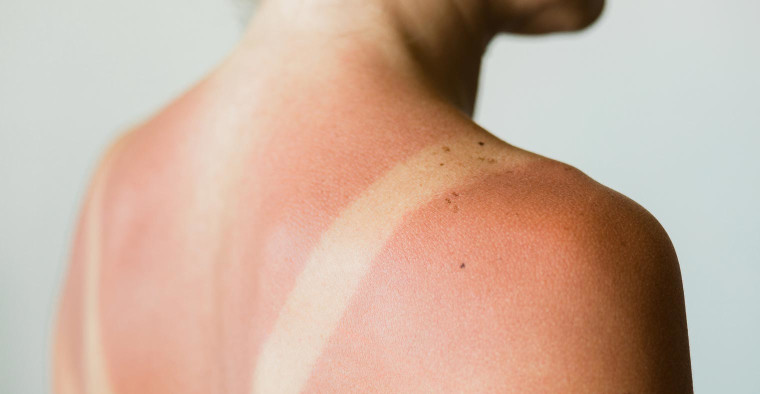
Is sunbathing the new smoking? Skin cancer, the most common form of cancer, kills more than two Americans every hour, according to the nonprofit Skin Cancer Foundation. But many consumers may not be doing everything they can to prevent it.
Just one sunburn can increase the risk of skin cancer, and 45% of Americans have already gotten scorched in the sun this year, according to the latest ValuePenguin survey of nearly 1,050 consumers.
Millions of Americans receive a skin cancer diagnosis each year, with treatments costing billions of dollars nationwide, but consumers can take low-cost steps to help decrease the risk of skin cancer and other complications from sun exposure.
Key findings
- One sunburn can increase the risk of skin cancer, and nearly half of consumers have already been sunburned this year. 45% of Americans have already been sunburned this year, and the rate is higher among the younger generations (61% of Gen Zers and 58% of millennials).
- The vast majority of Americans don’t wear sunscreen daily during the summer. 82% say they don’t wear sunscreen every day during the summer. That figure only drops to 64% if you exclude those who typically wear sunscreen five to six days a week.
- Nearly half of Americans aren’t confident they can detect a cancerous mole themselves, but most haven’t visited a doctor for a professional skin exam. 45% don’t think they could detect a cancerous mole on their body, but roughly the same percentage (43%) have never been given a full skin exam. More than a third of respondents (35%) say they have not done so due to cost concerns.
- Skin cancer is personal for many, and those who know someone impacted by it are more likely to practice prevention. 49% of respondents have a loved one who has or has had skin cancer. Those who know someone with skin cancer are more likely to wear sunscreen year-round than those who don’t (32% versus 19%), and they’re also more likely to have been screened themselves.
- Health savings accounts (HSAs) and flexible spending accounts (FSAs) help consumers save money on sunscreen, but many aren’t aware it’s an eligible expense. 43% didn’t know funds from an HSA or FSA could be used to purchase sunscreen (as long as the sunscreen is SPF 15 or higher and offers broad-spectrum protection).
Nearly half of Americans kick off summer with a sunburn
Though researchers surveyed consumers as the calendar turned to summer, 45% of Americans had already received their first sunburn of the year. Younger consumers reported higher rates of sunburns, with 61% of Gen Zers (ages 18 to 24) and 58% of millennials (ages 25 to 40) admitting to burns this year.
While it’s plausible that the possible end of the coronavirus pandemic has people eager to spend more time outside or travel to tropical destinations, it appears many may have neglected proper sun protection in the process.
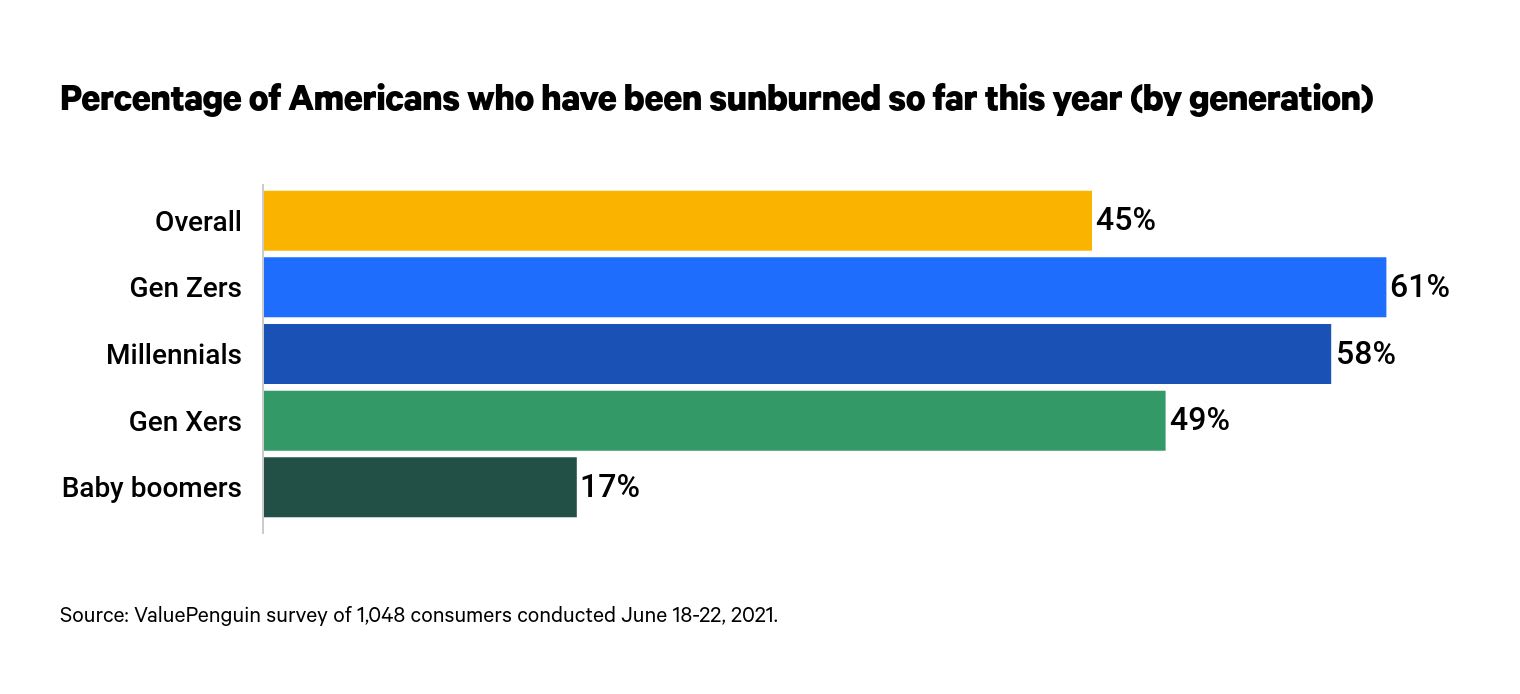
Of course, summer isn’t the only time people can get sunburned — especially if they live in a warmer climate. Yet only 1 in 4 consumers say they wear sunscreen year-round. Even in the summer, only 37% of people say they wear sunscreen daily or nearly every day. Consumers in the West are most likely to wear sunscreen year-round (31%, versus 26% in the South, 25% in the Northeast and 18% in the Midwest).
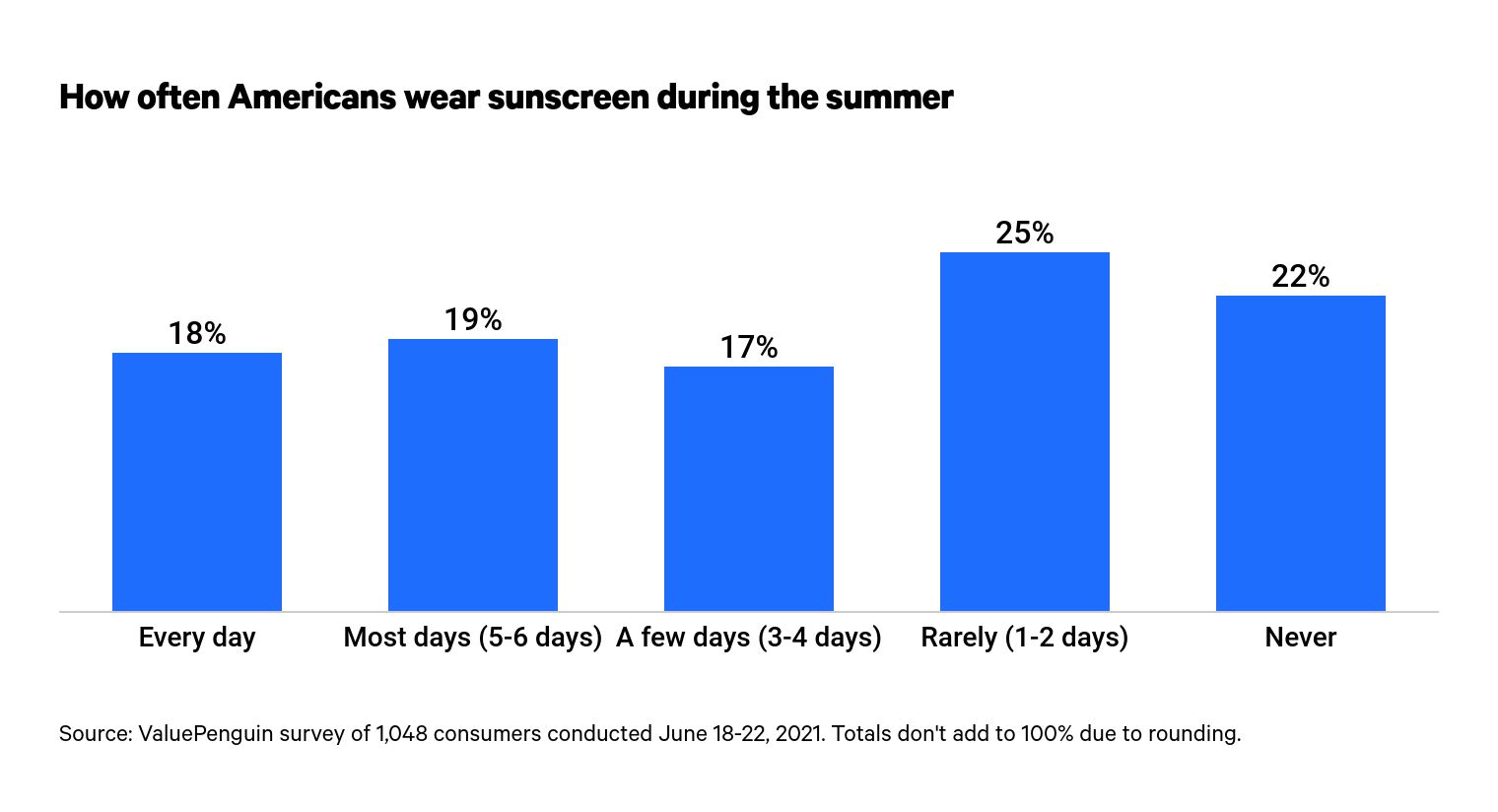
Just one sunburn represents enough sun exposure to increase the risk of skin cancer. And though people are less likely to be lying in the sun in the winter, sun exposure is just as dangerous then as it is in the summer.
Lack of protection plus lack of detection can be costly
While many consumers likely know the risk exists and that sun exposure can increase that risk, it appears many won’t know when the possibility of skin cancer becomes a reality.
Doctors need a skin biopsy to diagnose skin cancer, but 43% of consumers say they’ve never had a professional skin exam. Perhaps worse, 45% of people don’t think they could detect a cancerous mole on their body.
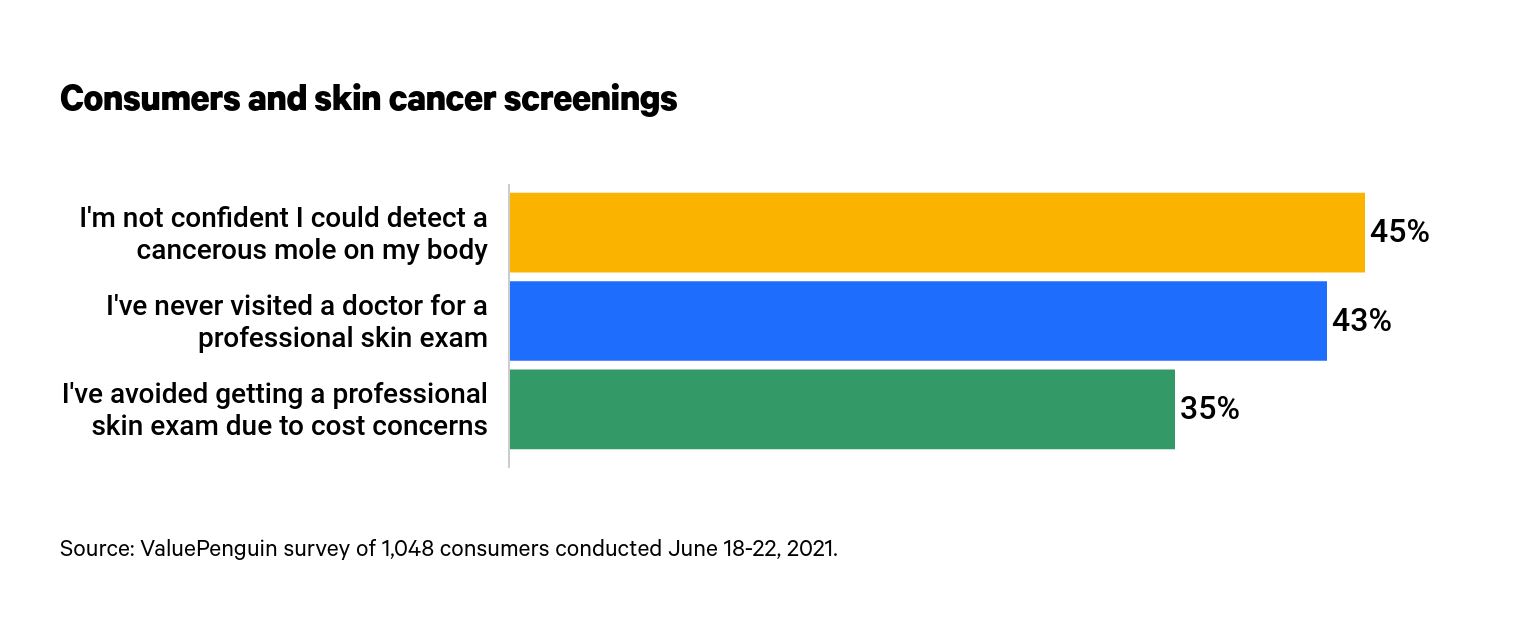
Most health insurance plans should cover medically necessary dermatologist visits like skin cancer screenings.
Still, 35% of respondents say they haven’t had a skin exam out of fear of the cost. Without insurance, an initial visit can cost around $150, but ValuePenguin insurance analyst Sterling Price says neglecting to get checked can be more costly in the long run.
"It will almost always save you money by going in and getting something checked instead of letting it sit around and perhaps worsen," Price says.
Skin cancer hits close to home
Being the most common form of cancer, it shouldn't be surprising that 49% of consumers have a loved one — whether a spouse, family member or friend — who’s been diagnosed with skin cancer. Though skin cancer has a strong survival rate, treatment can vary in price and complication.
Those who have or have had skin cancer seem to be serving as examples to their loved ones. People who know someone with skin cancer are more likely to wear sunscreen year-round (32%) than the 19% who wear it year-round but don’t know anyone who’s dealt with skin cancer.
That personal connection may be encouraging more consumers to get regular screenings, too, as those who have known someone with skin cancer are more likely to have been screened themselves.
Health savings and flexible spending accounts can help save your money and your skin
Before consumers get concerned about a mole or spot on their skin, they can — and should — take advantage of affordable sun protection. Funds in health savings accounts (HSAs) and flexible spending accounts (FSAs) can be used to purchase broad-spectrum sunscreen that is SPF 15 or higher, but 43% of Americans don’t realize this.
"People may think of contributions as money leaving their pockets since it is taken from their salary before taxes," Price says. "But they need to realize that the money in that account can actually be used for a ton of items that they might be buying anyway."
Anyone who has had a bad sunburn — 77% of respondents — knows the stinging, itching pain might be motivation enough to use sunscreen regularly. But consistent long-term use can also help lower the risk of skin cancer and reduce signs of skin aging — the latter of which could make some people run to the dermatologist only to find cosmetic treatments not covered by insurance.
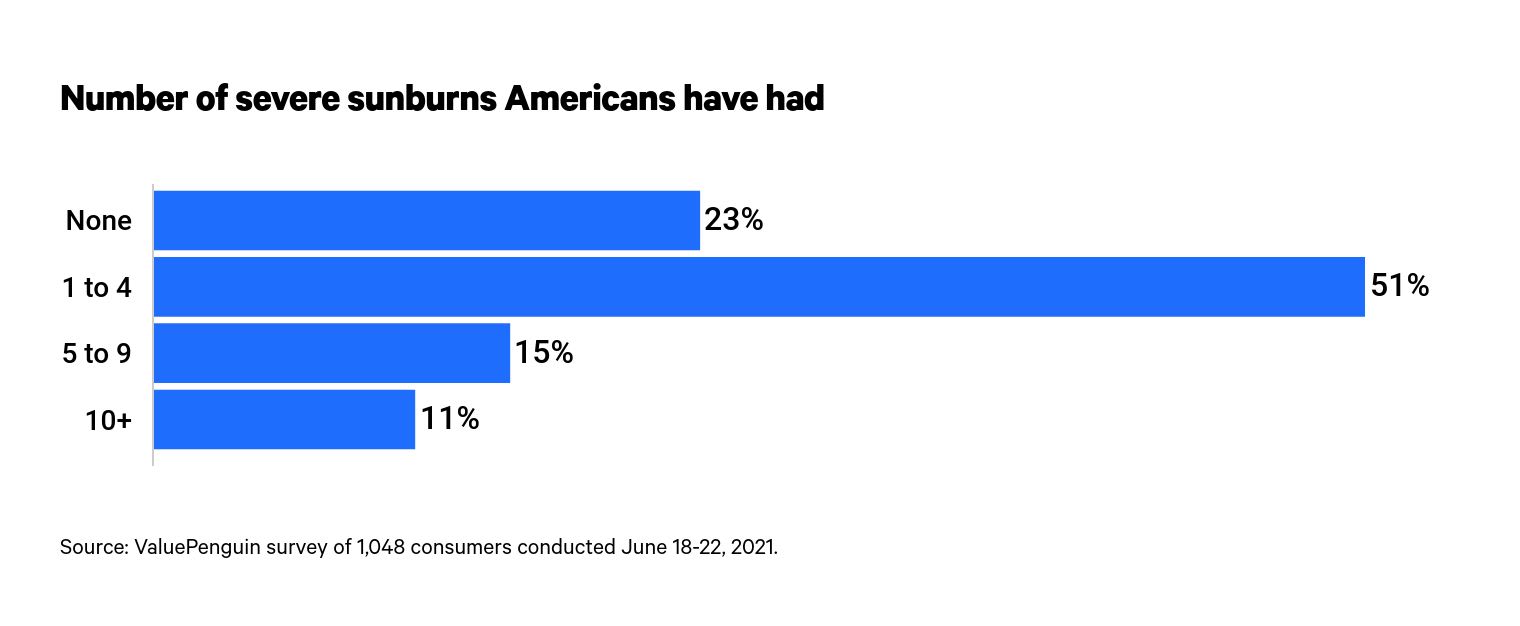
With or without health insurance, it’s likely a few bottles of good sunscreen — or avoiding too much sun exposure altogether — will run much cheaper than treatments for skin cancer or other complications from sun damage. While your health insurance provider is there to help when you need medical attention, prevention can help preserve your physical and financial well-being.
Methodology
ValuePenguin commissioned Qualtrics to conduct an online survey of 1,048 U.S. consumers from June 18 to June 22, 2021. The survey was administered using a nonprobability-based sample, and quotas were used to ensure the sample base represented the overall population. All responses were reviewed by researchers for quality control.
We defined generations as the following ages in 2021:
- Generation Z: 18 to 24
- Millennial: 25 to 40
- Generation X: 41 to 55
- Baby boomer: 56 to 75
While the survey also included consumers from the silent generation (defined as those 76 and older), the sample size was too small to include findings related to that group in the generational breakdowns.
